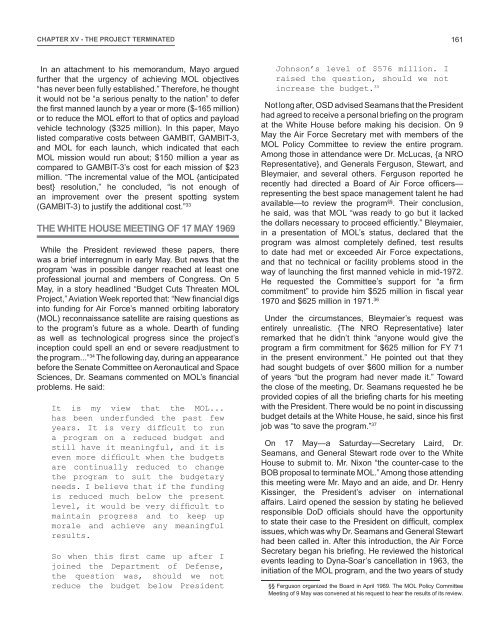NRO-MOL_2015
Create successful ePaper yourself
Turn your PDF publications into a flip-book with our unique Google optimized e-Paper software.
Chapter XV - THE PROJECT TERMINATED<br />
161<br />
In an attachment to his memorandum, Mayo argued<br />
further that the urgency of achieving <strong>MOL</strong> objectives<br />
“has never been fully established.” Therefore, he thought<br />
it would not be “a serious penalty to the nation” to defer<br />
the first manned launch by a year or more ($-165 million)<br />
or to reduce the <strong>MOL</strong> effort to that of optics and payload<br />
vehicle technology ($325 million). In this paper, Mayo<br />
listed comparative costs between GAMBIT, GAMBIT-3,<br />
and <strong>MOL</strong> for each launch, which indicated that each<br />
<strong>MOL</strong> mission would run about; $150 million a year as<br />
compared to GAMBIT-3’s cost for each mission of $23<br />
million. “The incremental value of the <strong>MOL</strong> {anticipated<br />
best} resolution,” he concluded, “is not enough of<br />
an improvement over the present spotting system<br />
(GAMBIT-3) to justify the additional cost.” 33<br />
The White House Meeting of 17 May 1969<br />
While the President reviewed these papers, there<br />
was a brief interregnum in early May. But news that the<br />
program ‘was in possible danger reached at least one<br />
professional journal and members of Congress. On 5<br />
May, in a story headlined “Budget Cuts Threaten <strong>MOL</strong><br />
Project,” Aviation Week reported that: “New financial digs<br />
into funding for Air Force’s manned orbiting laboratory<br />
(<strong>MOL</strong>) reconnaissance satellite are raising questions as<br />
to the program’s future as a whole. Dearth of funding<br />
as well as technological progress since the project’s<br />
inception could spell an end or severe readjustment to<br />
the program...” 34 The following day, during an appearance<br />
before the Senate Committee on Aeronautical and Space<br />
Sciences, Dr. Seamans commented on <strong>MOL</strong>’s financial<br />
problems. He said:<br />
It is my view that the <strong>MOL</strong>...<br />
has been underfunded the past few<br />
years. It is very difficult to run<br />
a program on a reduced budget and<br />
still have it meaningful, and it is<br />
even more difficult when the budgets<br />
are continually reduced to change<br />
the program to suit the budgetary<br />
needs. I believe that if the funding<br />
is reduced much below the present<br />
level, it would be very difficult to<br />
maintain progress and to keep up<br />
morale and achieve any meaningful<br />
results.<br />
So when this first came up after I<br />
joined the Department of Defense,<br />
the question was, should we not<br />
reduce the budget below President<br />
Johnson’s level of $576 million. I<br />
raised the question, should we not<br />
increase the budget. 35<br />
Not long after, OSD advised Seamans that the President<br />
had agreed to receive a personal briefing on the program<br />
at the White House before making his decision. On 9<br />
May the Air Force Secretary met with members of the<br />
<strong>MOL</strong> Policy Committee to review the entire program.<br />
Among those in attendance were Dr. McLucas, {a <strong>NRO</strong><br />
Representative}, and Generals Ferguson, Stewart, and<br />
Bleymaier, and several others. Ferguson reported he<br />
recently had directed a Board of Air Force officers—<br />
representing the best space management talent he had<br />
available—to review the program §§ . Their conclusion,<br />
he said, was that <strong>MOL</strong> “was ready to go but it lacked<br />
the dollars necessary to proceed efficiently.” Bleymaier,<br />
in a presentation of <strong>MOL</strong>’s status, declared that the<br />
program was almost completely defined, test results<br />
to date had met or exceeded Air Force expectations,<br />
and that no technical or facility problems stood in the<br />
way of launching the first manned vehicle in mid-1972.<br />
He requested the Committee’s support for “a firm<br />
commitment” to provide him $525 million in fiscal year<br />
1970 and $625 million in 1971. 36<br />
Under the circumstances, Bleymaier’s request was<br />
entirely unrealistic. {The <strong>NRO</strong> Representative} later<br />
remarked that he didn’t think “anyone would give the<br />
program a firm commitment for $625 million for FY 71<br />
in the present environment.” He pointed out that they<br />
had sought budgets of over $600 million for a number<br />
of years “but the program had never made it.” Toward<br />
the close of the meeting, Dr. Seamans requested he be<br />
provided copies of all the briefing charts for his meeting<br />
with the President. There would be no point in discussing<br />
budget details at the White House, he said, since his first<br />
job was “to save the program.” 37<br />
On 17 May—a Saturday—Secretary Laird, Dr.<br />
Seamans, and General Stewart rode over to the White<br />
House to submit to. Mr. Nixon “the counter-case to the<br />
BOB proposal to terminate <strong>MOL</strong>.” Among those attending<br />
this meeting were Mr. Mayo and an aide, and Dr. Henry<br />
Kissinger, the President’s adviser on international<br />
affairs. Laird opened the session by stating he believed<br />
responsible DoD officials should have the opportunity<br />
to state their case to the President on difficult, complex<br />
issues, which was why Dr. Seamans and General Stewart<br />
had been called in. After this introduction, the Air Force<br />
Secretary began his briefing. He reviewed the historical<br />
events leading to Dyna-Soar’s cancellation in 1963, the<br />
initiation of the <strong>MOL</strong> program, and the two years of study<br />
§§ Ferguson organized the Board in April 1969. The <strong>MOL</strong> Policy Committee<br />
Meeting of 9 May was convened at his request to hear the results of its review.

















